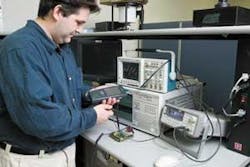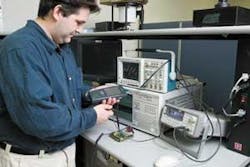By John Keller
STERLING HEIGHTS, Mich. - Leaders of the General Dynamics Land Systems Division in Sterling Heights, Mich., are zeroing in on how the company manages test equipment as a way to cut costs and improve engineering productivity.
Land Systems, which produces the M1 Abrams main battle tank, Stryker armored vehicle, the Light Armored Vehicle, and other front-line land combat vehicles, started the Test Resource Management program in 2002 and is starting to see results.
The program seeks to make the most of how the company and its people acquire, use, share, and dispose of test equipment like spectrum analyzers or oscilloscopes. It also involves metrics for measuring performance and return on investment.
“Prior to implementing Test Resource Management, all of our labs were working independently of each other,” says Norm LaPrise who manages vetronics engineering at General Dynamics Land Systems. “We were running out of lab space to store test equipment, and we were finding equipment that had been purchased months earlier and was never used, still new in its box.”
The program helped General Dynamics leaders exceed their 2004 capital avoidance goal by more than 100 percent, and top their operating expense savings and cash-flow targets by more than 300 percent, company officials say.
Moreover, the program has given engineers access to more modern and effective test equipment, freed up lab space, and has broken down departmental stovepipes.
General Dynamics is now a far cry from the industry norm, experts say. “Across the industry, we see utilization of test equipment at 10 to 15 percent, meaning equipment is sitting unused 85 to 90 percent of the time,” says Paul McNamara, chief executive officer of the Sente Group in Atlanta, a General Dynamics consultant in place to help the company improve business practices.
“Old and nonstandard technologies add cost and risk to development,” McNamara says. “It’s not unusual for more than 50 percent of deployed equipment to be obsolete, veritable ticking time bombs at the core of crucial product development processes.”
Test equipment downtime is expensive. The typical piece of equipment costs $5,000 to $150,000 new. “A typical large defense contractor has $50 million worth of test equipment at a single location,” McNamara says.
Before starting the program, company engineering leaders did not have a full understanding of test-asset utilization within their departments. “We’ve yet to come across a company that has rigorous metrics for tracking test equipment utilization,” McNamara says.
Teams from General Dynamics and Sente identified goals such as technology sharing and standardization, forecasting demand for test technology, and securing buy-in from key constituents.
General Dynamics launched a beta test in August 2002. Progress since then has not been easy, but certainly has been worth it, officials say.
“We knew that users of equipment can be the biggest roadblocks to driving change in test environments-even where management has formally endorsed a new program,” LaPrise says. “They also don’t forget when past ‘initiatives of the month’ were forced on them, produced no returns, and ultimately went away.”
To overcome these obstacles, General Dynamics and Sente experts made sure that key people understood the costs and benefits of the program, and “had to demonstrate that the initial implementation wouldn’t disrupt the organization,” McNamara says.
The General Dynamics team also consolidated new equipment purchases to gain cost benefits and remove potential roadblocks within each department, which not only free up test equipment and capital, but also gave all users more frequent access to new technologies.
“This program was one of the first engineering initiatives focused on the output of the entire system’s architecture, which led to the shift of our laboratory and test equipment culture from a stovepipe mentality to an integrated team across the organization,” LaPrise says.
“Test Resource Management has been instrumental in changing the mindset of engineering to think in terms of sharing the test equipment, and treating the test environment as a business within a business,” he says.




